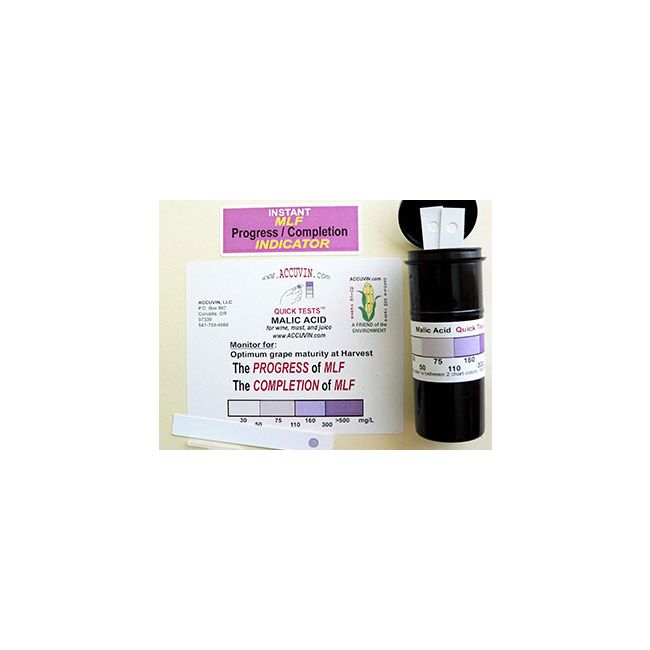Malic Acid Test Strips
The Accuvin Malic Acid Wine Test Kit is used to monitor the decrease in malic acid during malolactic fermentation (MLF). The test range is from 0 500 mg/L.
Malolactic fermentation, the secondary fermentation in winemaking, is a method of reducing total titratable acidity by adjusting the relative concentrations of L-malic and L-lactic acids, softening the wine and allowing it to develop mellowness and full-bodiedness. This process also results in microbial stability since one of the key ingredients of spoilage is removed.
Our Malic Acid Test Strips monitors the decrease in malic acid from 500 mg/L to 0 mg/L indicating the completion of malolactic fermentation. No color indicates a malic acid concentration at or near 0 mg/L. Test kits contain the number of tests and samplers that correspond to the size of the kit.
REASONS TO USE MALIC ACID TESTS
Accuvin has developed a unique membrane, built into each test strip, which selectively removes interfering color pigments. Thus allowing this kit to be used for both red and white wines, and require no adjustments or pretreatments.
Keeping track of the malolactic fermentation progress allows the detection of problems when they are small and require less intervention to fix. Our strips serve as an ideal method of determining the completion of MLF and provide many of the worlds most regarded winemakers an ideal primary method for testing. The highly portable nature of our tests as well as their rapid results make them a commonly used method for confirmation of MLF completion. It is also often used prior to paper chromatography and determination of which barrels are ready for a more precise but slower testing method.
Know where in the MLF process your wine is at any moment by monitoring with our Malic Acid Test Kit.
Track MLF by the barrel or at various depths of a large tank with our Malic Acid Tests, so you will not have to assume MLF is progressing similarly throughout with a combined sample.
Monitoring with Malic Acid Tests enables you to stop MLF at 75 mg/L, 50 mg/L or 0 mg/L, allowing you to choose how soft, mellow, or full-bodied you want your wines.
At harvest you can monitor with Malic Acid Tests to quantify decreasing malic acid as grapes approach optimum ripeness. Malic acid levels tend to decrease faster than tartaric acid levels, especially in warmer areas. This enables finer control over when to pick.
| Drop Shipped | No |
|---|---|
| Freight Shipped | No |
| Super Saver Shipping | Yes |
| Special Order | No |



